Charming and elegant Vera Vergani (1894-1989) was primarily an Italian stage actress, famous for her interpretations in the first stagings of Luigi Pirandello’s plays. She became one of the popular divas of the Italian cinema when she appeared in a dozen silent films between 1917 and 1921 for directors like Augusto Genina and Roberto Roberti.
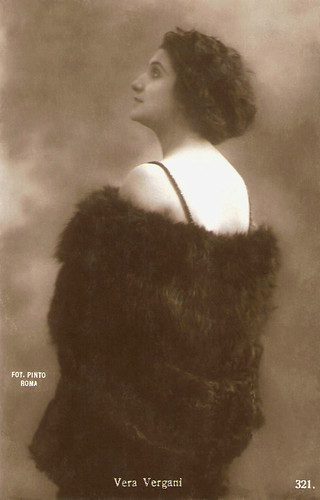
Italian postcard by Edizione A. Traldi, Milano, no. 321. Photo: Pinto, Roma.
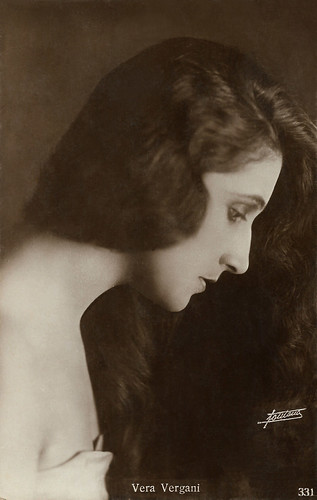
Italian postcard by Ed. A. Traldi, Milano, no. 331. Photo: Fontana.

Italian postcard by Ed. A. Traldi, Milano, no. 475 Photo: Badodi.

Italian postcard by Ed. A Traldi, Milano, no. 502. Photo: Badodi.
Vera Vergani was born in Milan, Lombardy, in 1894. She was the granddaughter of puppet master Vittorio Podrecca and sister of journalist and playwright Orio Vergani.
She debuted on stage in 1912 at the Benini company. Two years later she joined the Talli-Melato-Giovannini company and in 1916 she became ‘primattrice’ (leading lady) in the company of the famous actor Ruggero Ruggeri.
Vera Vergani was only 21 at the time. She played Ophelia in William Shakespeare’s Hamlet and had a huge success with the title role in Gabriele D’Anunzio’s La Figlia di Jorio (The Daughter of Jorio). She would play that role again and again.
In 1916 film producer Giovanni Xilo managed to lure the popular actress to work for his Monopol-Rome Film. He hoped to add prestige to his productions with big names of the stage. Producers had done so earlier with Lyda Borelli and Ermete Zacconi.
When her stage company was at rest in the summertime, Vergani played in two films for which Augusto Genina had written the original scripts: Il presagio/The Presentiment (Augusto Genina, 1916) and La menzogna/The Lie (Augusto Genina, 1916) with Tullio Carminati and Oreste Bilancia. They were produced at the same time, using the same cast and crew, at the Cines film studio, which was rented for the occasion.
As the publicity indicates, Il presagio was "the drama of a beautiful woman who seems to be born for the joy of the eyes and for love, but instead meets futile caprice and tragic passion". La menzogna is "the violent story of a woman ready to sacrifice her honour to save her husband, but justice protects the good ones and will prevail in the end".
The films did not have a very good reception and Vergani was accused of betraying the theatre. "It is a night without a moonbeam", one critic wrote, and Vera didn’t want to know about film anymore for several years.
On stage, she was very successful again with both critics and audiences in plays by Luigi Pirandello and Gabriele D'Annunzio. In the 1910s and 1920s, she remained foremost a stage actress, appreciated not only for her beauty and elegance but also for her excellent interpretations.

Italian postcard by Ed. Ballerini & Fratini Co., Firenze, no. 601/2. Photo: Massaglia, Torino.

Italian postcard by Ed. Ballerini & Fratini Co., Firenze, no. 601/5. Photo: Massaglia, Torino.

Italian postcard by Ed. Ballerini & Fratini, Firenze, no. 601/6. Photo: Massaglia, Torino.

Italian postcard by neg. Vettori, Bologna, no. 62.
In 1919, Vera Vergani returned to the screen. Giuseppe Barattolo, producer at Caesar Film, offered her to play in three films based on famous stage plays: Dora o le spie/Dora or the spies (Robert Roberti, 1919) written by Victorien Sardou, La paura d'amare/Fear of love (Robert Roberti, 1920) by Dario Niccodemi and Giulia di Trécoeur/Lucie de Trecoeur (Camillo De Riso, Augusto Genina, 1921) by Octave Feuillet.
Robert Roberti had made his career as the director of films with diva Francesca Bertini. The critics didn’t like his direction too much but were full of praise for Vera’s lively interpretation of the dramas, along with her style of performance on stage.
Another film based on a play by Niccodemi followed, L'envolée/La volata/The sprint (1919). In the film, Vera is dressed as a daring aviator, ‘flaming expression of the new’ as one critic wrote, who also noted in the aviation to see ‘the clearest emergence of these times’.
The actress also played in the film La modella/The model (Mario Caserini, 1920) based on a comedy by Alfredo Testoni, La buona figliola/The good daughter (Mario Caserini, 1919) based on Sabatino Lopez, Fior d'amore/Flower of love (Mario Caserini, 1921) again based on Niccodemi, and Caterina (Mario Caserini, 1921) written by Henri Lavedan.
Her co-star in these films was Nerio Bernardi. She often repeated on screen, of which by now she knew all the odds and outs, her previous stage performances. But after La Vittima/The Victim (Jacques Creusy, 1921), a neglectable tearjerker, she returned to the stage for good.
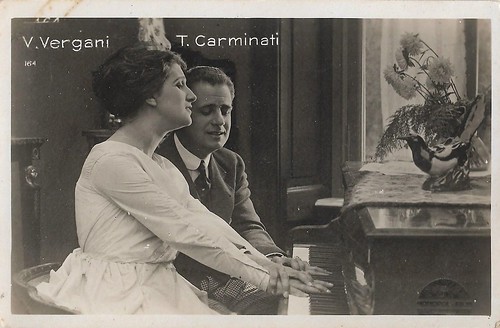
Italian postcard by Neg. Vettori, Bologna, no. 164. At the company Monopol-Film, Vera Vergani and Tullio Carminati played in a series of films directed by Augusto Genina in 1916-1918, like the successful films Il presagio (1916) and La menzogna (1916).

Italian postcard by Neg. Vettori, Bologna. Photo: Badodi, Milano. Sent by mail in 1927.
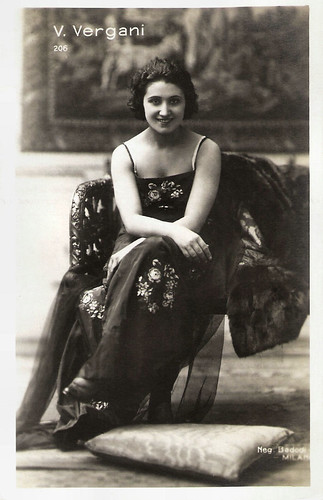
Italian postcard by Neg. Vettori, Bologna, no. 206. Photo: Badodi.

Italian postcard by Neg. Vettori, Bologna, no. 265.
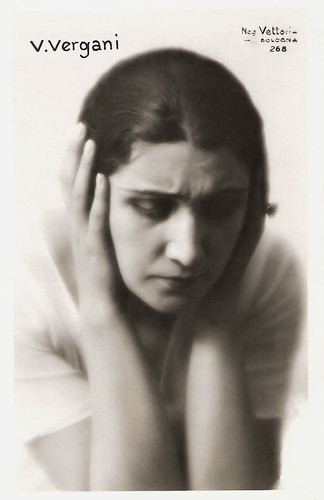
Italian postcard by Neg. Vettori, Bologna, no. 268.
During the fundamental years of her stage career, Vera Vergani played for the company of Dario Niccodemi. From 1921 on, she was the company's ‘primattrice’ for nine seasons. Her regular male co-star was Luigi Cimara.
Memorable from these years were her performances in the first stagings of Luigi Pirandello’s plays 'Sei personaggi in cerca d'autore' (Six Characters in Search of an Author) (1921) and 'Ciascuno a suo modo' (Each on His Own Way) (1924).
After the world premiere of Sei personaggi in cerca d'autore, hundreds of people flooded the stage and yelled violently at the author. The public, accustomed to conventional theater did not accept the avant-garde text.
Pirandello had to barricade himself in Vergani’s dressing room. The beautiful actress suddenly stepped forward, made a silencing gesture to the raging crowd, and declared smiling sweetly: “Prima di toccare Pirandello dovete passare sul mio cadavere.“ (Before you touch Pirandello, you will have to pass my dead body). Pirandello survived and nowadays his play is considered a classic of the Italian theatre.
Vittorio Paliotti writes at the website L’Isola that Vergani's photos graced the covers of European magazines and that she received an ‘avalanche’ with love letters from all over the world. Before her performances, her dressing rooms were transformed into greenhouses.
The fascinating and elegant actress retired in 1930, after a last performance at the Teatro Manzoni in Milan. She starred once more in the play which had contributed to her fortune: 'La figlia di Iorio' by Gabriele D'Annunzio.
The reason for her retirement was her marriage with Leonardo Pescarolo, a naval officer from the island of Procida. They had two children: assistant director Vera Pescarolo, who would become the wife of film director Giuliano Montaldo, and film producer Leo Pescarolo.
Vera Vergano returned once to the cinema. In 1965 she appeared in a small role in Il morbidone/The Dreamer (Massimo Franciosa, 1965) with Anouk Aimée.
Vera Vergani died in Procida in 1989. She was 95. Her granddaughter and great-grandchildren are also working in the film business: costume designer Elisabetta Montaldo, assistant director Inti Carboni and makeup designer Jana Carboni.

Italian postcard.

Italian postcard by Fotocelere, no. 86. Photo: publicity still of Vergani with Tullio Carminati.

Italian postcard, no. 74. Sent by mail in 1924. Photo: publicity still of Vergani with Tullio Carminati.
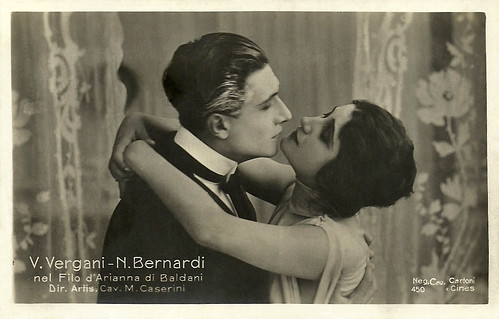
Italian postcard by G. Vettori, Bologna, no. 450. Photo: Cines. Vera Vergani and Nerio Bernardi in Il filo d'Arianna/Ariadne's thread (Mario Caserini, 1921).

Italian postcard by G. Vettori, Bologna, no. 451. Photo: Renato Cartoni (who was also the cameraman). Vera Vergani and Nerio Bernardi in Il filo d'Arianna/Ariadne's thread (Mario Caserini, 1921).

Italian postcard by G. Vettori, Bologna, no. 453. Photo: Renato Cartoni (who was also the cameraman). Vera Vergani and Nerio Bernardi in Il filo d'Arianna/Ariadne's thread (Mario Caserini, 1921).

Italian postcard by G. Vettori, Bologna, no. 454. Photo: Renato Cartoni (who was also the cameraman). Vera Vergani and Nerio Bernardi in Il filo d'Arianna/Ariadne's thread (Mario Caserini, 1921).
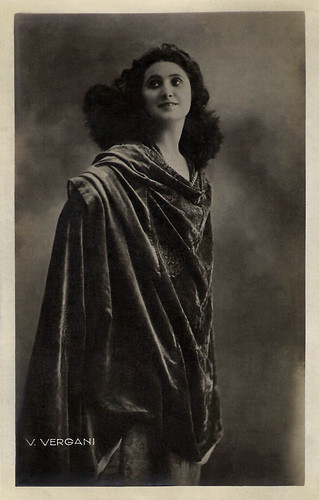
Italian postcard by Vettori, Bologna.

Italian postcard by Fotocelere, Torino.

Italian postcard by Fotocelere, Torino (Turin), no. 280. Photo: Badodi.

Italian postcard by Fotocelere, Torino (Turin), no. 282. Photo: Badodi.
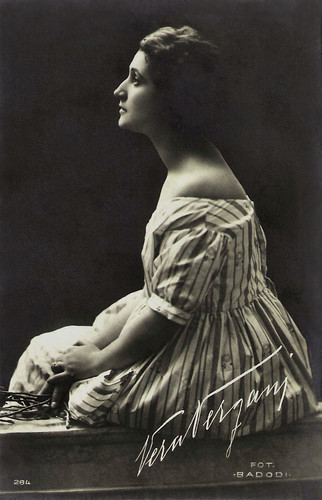
Italian postcard by Fotocelere, Torino (Turin), no. 284. Photo: Badodi.
Sources: Vittorio Martinelli (Le dive del silenzio - Italian), Vittorio Paliotti (L’Isola - Italian - now defunct), Procidamia (Italian - now defunct) and IMDb.
This post was last updated on 3 July 2020.

Italian postcard by Edizione A. Traldi, Milano, no. 321. Photo: Pinto, Roma.

Italian postcard by Ed. A. Traldi, Milano, no. 331. Photo: Fontana.

Italian postcard by Ed. A. Traldi, Milano, no. 475 Photo: Badodi.

Italian postcard by Ed. A Traldi, Milano, no. 502. Photo: Badodi.
Primattrice
Vera Vergani was born in Milan, Lombardy, in 1894. She was the granddaughter of puppet master Vittorio Podrecca and sister of journalist and playwright Orio Vergani.
She debuted on stage in 1912 at the Benini company. Two years later she joined the Talli-Melato-Giovannini company and in 1916 she became ‘primattrice’ (leading lady) in the company of the famous actor Ruggero Ruggeri.
Vera Vergani was only 21 at the time. She played Ophelia in William Shakespeare’s Hamlet and had a huge success with the title role in Gabriele D’Anunzio’s La Figlia di Jorio (The Daughter of Jorio). She would play that role again and again.
In 1916 film producer Giovanni Xilo managed to lure the popular actress to work for his Monopol-Rome Film. He hoped to add prestige to his productions with big names of the stage. Producers had done so earlier with Lyda Borelli and Ermete Zacconi.
When her stage company was at rest in the summertime, Vergani played in two films for which Augusto Genina had written the original scripts: Il presagio/The Presentiment (Augusto Genina, 1916) and La menzogna/The Lie (Augusto Genina, 1916) with Tullio Carminati and Oreste Bilancia. They were produced at the same time, using the same cast and crew, at the Cines film studio, which was rented for the occasion.
As the publicity indicates, Il presagio was "the drama of a beautiful woman who seems to be born for the joy of the eyes and for love, but instead meets futile caprice and tragic passion". La menzogna is "the violent story of a woman ready to sacrifice her honour to save her husband, but justice protects the good ones and will prevail in the end".
The films did not have a very good reception and Vergani was accused of betraying the theatre. "It is a night without a moonbeam", one critic wrote, and Vera didn’t want to know about film anymore for several years.
On stage, she was very successful again with both critics and audiences in plays by Luigi Pirandello and Gabriele D'Annunzio. In the 1910s and 1920s, she remained foremost a stage actress, appreciated not only for her beauty and elegance but also for her excellent interpretations.

Italian postcard by Ed. Ballerini & Fratini Co., Firenze, no. 601/2. Photo: Massaglia, Torino.

Italian postcard by Ed. Ballerini & Fratini Co., Firenze, no. 601/5. Photo: Massaglia, Torino.

Italian postcard by Ed. Ballerini & Fratini, Firenze, no. 601/6. Photo: Massaglia, Torino.

Italian postcard by neg. Vettori, Bologna, no. 62.
Flaming Expression of the New
In 1919, Vera Vergani returned to the screen. Giuseppe Barattolo, producer at Caesar Film, offered her to play in three films based on famous stage plays: Dora o le spie/Dora or the spies (Robert Roberti, 1919) written by Victorien Sardou, La paura d'amare/Fear of love (Robert Roberti, 1920) by Dario Niccodemi and Giulia di Trécoeur/Lucie de Trecoeur (Camillo De Riso, Augusto Genina, 1921) by Octave Feuillet.
Robert Roberti had made his career as the director of films with diva Francesca Bertini. The critics didn’t like his direction too much but were full of praise for Vera’s lively interpretation of the dramas, along with her style of performance on stage.
Another film based on a play by Niccodemi followed, L'envolée/La volata/The sprint (1919). In the film, Vera is dressed as a daring aviator, ‘flaming expression of the new’ as one critic wrote, who also noted in the aviation to see ‘the clearest emergence of these times’.
The actress also played in the film La modella/The model (Mario Caserini, 1920) based on a comedy by Alfredo Testoni, La buona figliola/The good daughter (Mario Caserini, 1919) based on Sabatino Lopez, Fior d'amore/Flower of love (Mario Caserini, 1921) again based on Niccodemi, and Caterina (Mario Caserini, 1921) written by Henri Lavedan.
Her co-star in these films was Nerio Bernardi. She often repeated on screen, of which by now she knew all the odds and outs, her previous stage performances. But after La Vittima/The Victim (Jacques Creusy, 1921), a neglectable tearjerker, she returned to the stage for good.

Italian postcard by Neg. Vettori, Bologna, no. 164. At the company Monopol-Film, Vera Vergani and Tullio Carminati played in a series of films directed by Augusto Genina in 1916-1918, like the successful films Il presagio (1916) and La menzogna (1916).

Italian postcard by Neg. Vettori, Bologna. Photo: Badodi, Milano. Sent by mail in 1927.

Italian postcard by Neg. Vettori, Bologna, no. 206. Photo: Badodi.

Italian postcard by Neg. Vettori, Bologna, no. 265.

Italian postcard by Neg. Vettori, Bologna, no. 268.
Over My Dead Body
During the fundamental years of her stage career, Vera Vergani played for the company of Dario Niccodemi. From 1921 on, she was the company's ‘primattrice’ for nine seasons. Her regular male co-star was Luigi Cimara.
Memorable from these years were her performances in the first stagings of Luigi Pirandello’s plays 'Sei personaggi in cerca d'autore' (Six Characters in Search of an Author) (1921) and 'Ciascuno a suo modo' (Each on His Own Way) (1924).
After the world premiere of Sei personaggi in cerca d'autore, hundreds of people flooded the stage and yelled violently at the author. The public, accustomed to conventional theater did not accept the avant-garde text.
Pirandello had to barricade himself in Vergani’s dressing room. The beautiful actress suddenly stepped forward, made a silencing gesture to the raging crowd, and declared smiling sweetly: “Prima di toccare Pirandello dovete passare sul mio cadavere.“ (Before you touch Pirandello, you will have to pass my dead body). Pirandello survived and nowadays his play is considered a classic of the Italian theatre.
Vittorio Paliotti writes at the website L’Isola that Vergani's photos graced the covers of European magazines and that she received an ‘avalanche’ with love letters from all over the world. Before her performances, her dressing rooms were transformed into greenhouses.
The fascinating and elegant actress retired in 1930, after a last performance at the Teatro Manzoni in Milan. She starred once more in the play which had contributed to her fortune: 'La figlia di Iorio' by Gabriele D'Annunzio.
The reason for her retirement was her marriage with Leonardo Pescarolo, a naval officer from the island of Procida. They had two children: assistant director Vera Pescarolo, who would become the wife of film director Giuliano Montaldo, and film producer Leo Pescarolo.
Vera Vergano returned once to the cinema. In 1965 she appeared in a small role in Il morbidone/The Dreamer (Massimo Franciosa, 1965) with Anouk Aimée.
Vera Vergani died in Procida in 1989. She was 95. Her granddaughter and great-grandchildren are also working in the film business: costume designer Elisabetta Montaldo, assistant director Inti Carboni and makeup designer Jana Carboni.

Italian postcard.

Italian postcard by Fotocelere, no. 86. Photo: publicity still of Vergani with Tullio Carminati.

Italian postcard, no. 74. Sent by mail in 1924. Photo: publicity still of Vergani with Tullio Carminati.

Italian postcard by G. Vettori, Bologna, no. 450. Photo: Cines. Vera Vergani and Nerio Bernardi in Il filo d'Arianna/Ariadne's thread (Mario Caserini, 1921).

Italian postcard by G. Vettori, Bologna, no. 451. Photo: Renato Cartoni (who was also the cameraman). Vera Vergani and Nerio Bernardi in Il filo d'Arianna/Ariadne's thread (Mario Caserini, 1921).

Italian postcard by G. Vettori, Bologna, no. 453. Photo: Renato Cartoni (who was also the cameraman). Vera Vergani and Nerio Bernardi in Il filo d'Arianna/Ariadne's thread (Mario Caserini, 1921).

Italian postcard by G. Vettori, Bologna, no. 454. Photo: Renato Cartoni (who was also the cameraman). Vera Vergani and Nerio Bernardi in Il filo d'Arianna/Ariadne's thread (Mario Caserini, 1921).

Italian postcard by Vettori, Bologna.

Italian postcard by Fotocelere, Torino.

Italian postcard by Fotocelere, Torino (Turin), no. 280. Photo: Badodi.

Italian postcard by Fotocelere, Torino (Turin), no. 282. Photo: Badodi.

Italian postcard by Fotocelere, Torino (Turin), no. 284. Photo: Badodi.
Sources: Vittorio Martinelli (Le dive del silenzio - Italian), Vittorio Paliotti (L’Isola - Italian - now defunct), Procidamia (Italian - now defunct) and IMDb.
This post was last updated on 3 July 2020.
1 comment:
She had the perfect face for silent films.
Post a Comment